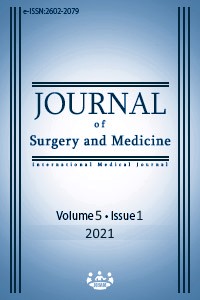Thrombocytopenia and its effect on mortality and morbidity in the intensive care unit
Keywords:
APACHE II, Intensive care, mortality, sepsis, thrombocytopeniaAbstract
Background/Aim: Thrombocytopenia is a common hematological abnormality among patients in the intensive care unit (ICU). The development of thrombocytopenia in the ICU usually indicates severe organ system dysfunction rather than a primary hematological disorder. We aimed to determine the incidence, causes, and clinical results of thrombocytopenia in patients followed up in ICU. Methods: In this retrospective cohort study, 165 patients who were followed up in the ICU with thrombocyte counts below 150,000 /uL were included and causes of thrombocytopenia, along with its effects on mortality and intensive care stay were investigated. Results: Thrombocytopenia was determined in 30.1% of the patients in the ICU. The cause of thrombocytopenia was sepsis in 33 (20.0%) of the patients and disseminated intravascular coagulation (DIC) in 20 (12.1%) patients. During the study period, 115 (69.7%) of 165 thrombocytopenic patients and 173 (45.1%) of 383 patients without thrombocytopenia died. Mortality was significantly higher in patients with thrombocytopenia. Mortality significantly increased when platelet count decreased, even with similar APACHE II scores. Conclusion: The most common causes of thrombocytopenia in the ICU were sepsis and DIC. Thrombocytopenia is common in the ICU and increases mortality rates.
Downloads
References
Levi M, Lowenberg EC. Thrombocytopenia in critically ill patients. Seminars in trombosis and Hemostasis. Thieme Medical Publishers, 2008;417-24.
Antier N, Quenot JP, Doise JM, Noel R, Demaistre E, Devilliers H. Mechanisms and etiologies of thrombocytopenia in the intensive care unit: impact of extensive investigations. Ann Intensive Care. 2014 Aug 2;4:24. doi: 10.1186/s13613-014-0024-x. PMID: 25593741; PMCID: PMC4273722.
Jonsson AB, Rygård SL, Russell L, Perner A, Møller MH. Bleeding and thrombosis in intensive care patients with thrombocytopenia-Protocol for a topical systematic review. Acta Anaesthesiol Scand. 2019 Feb;63(2):270-3. doi: 10.1111/aas.13268. Epub 2018 Oct 14. PMID: 30318582.
Murray NA. Evaluation and treatment of thrombocytopenia in the neonatal intensive care unit. Acta Paediatr Suppl. 2002;91(438):74-81. doi: 10.1111/j.1651-2227.2002.tb02908.x. PMID: 12477267.
Baughman RP, Lower EE, Flessa HC, Tollerud DJ. Thrombocytopenia in the intensive care unit. Chest. 1993 Oct;104(4):1243-7. doi: 10.1378/chest.104.4.1243. PMID: 8404200.
Knaus WA, Draper EA, Wagner DP, Zimmerman JE. APACHE II: a severity of disease classification system. Crit Care Med. 1985;13:818-29.
Rajadhyaksha GC, Meah A. Spectrum of Diseases/conditions Exhibiting Hemostatic Abnormalities in Patients Admitted to a Medical Intensive Care Unit of a Tertiary Care Hospital. Indian J Crit Care Med. 2018 Oct;22(10):711-7. doi: 10.4103/ijccm. IJCCM_505_17. PMID: 30405281; PMCID: PMC6201640.
Williamson DR, Lesur O, Tétrault JP, Nault V, Pilon D. Thrombocytopenia in the critically ill: prevalence, incidence, risk factors, and clinical outcomes. Can J Anaesth. 2013 Jul;60(7):641-51. doi: 10.1007/s12630-013-9933-7. Epub 2013 Apr 25. PMID: 23615940.
Crowther MA, Cook DJ, Meade MO, et al. Thrombocytopeniain medical-surgical critically ill patients: prevalence, incidence, and risk factors. J Crit Care. 2005;20:348-53.
Marck RE, Montagne HL, Tuinebreijer WE, Breederveld RS. Time course of thrombocytes in burn patients and its predictive value for outcome. Burns. 2013 Jun;39(4):714-22. doi: 10.1016/j.burns.2013.01.015. Epub 2013 Mar 13. PMID: 23490002.
Provan D, Arnold DM, Bussel JB, Chong BH, Cooper N, Gernsheimer T, et al. Updated international consensus report on the investigation and management of primary immune thrombocytopenia. Blood Adv. 2019 Nov 26;3(22):3780-817. doi: 10.1182/bloodadvances.2019000812. PMID: 31770441; PMCID: PMC6880896.
Peker A, Yarkıcı H, Akar H. Gastrointestinal bleeding secondary to use of high-dose methotrexate: A case report. J Surg Med. 2018;2(2)151-3. doi: 10.28982/josam.399081
İnanç Y, İnanç Y. An evaluation of the infection agents and the demographic characteristics of patients followed up on a mechanical ventilator in neurology intensive care: A retrospective, single center, observational study. J Surg Med. 2018;2(3):262-4. doi: 10.28982/josam.427084
Helling H, Stephan B, Pindur G. Coagulation and complement system in critically ill patients. Clin Hemorheol Microcirc. 2015;61(2):185-93. doi: 10.3233/CH-151993. PMID: 26410872.
Duran, M, Uludag, Ö. Mortality analysis of hospitalized trauma patients in the intensive care unit. J Surg Med. 2020;4(11):994-7. doi: 10.28982/josam.780138
Thachil J, Warkentin TE. How do we approach thrombocytopenia in critically ill patients? Br J Haematol. 2017 Apr;177(1):27-38. doi: 10.1111/bjh.14482. Epub 2016 Dec 16. PMID: 27982413.
Knöbl P. Thrombopenie auf der Intensivstation: Diagnose, Differenzialdiagnose und Therapie [Thrombocytopenia in the intensive care unit: Diagnosis, differential diagnosis, and treatment]. Med Klin Intensivmed Notfmed. 2016 Jun;111(5):425-33. German. doi: 10.1007/s00063-016-0174-8. Epub 2016 Jun 2. PMID: 27255225; PMCID: PMC7095953.
Hanes SD, Quarles DA, Boucher BA. Incidence and risk factors of thrombocytopenia in critically ill trauma patients. Ann Pharmacother. 1997 Mar;31(3):285-9. doi: 10.1177/106002809703100302. PMID: 9066932.
Zarychanski R, Houston DS. Assessing thrombocytopenia in the intensive care unit: the past, present, and future. Hematology Am Soc Hematol Educ Program. 2017 Dec 8;2017(1):660-6. doi: 10.1182/asheducation-2017.1.660. PMID: 29222318; PMCID: PMC6142536.
Hoogendoorn ME, Margadant CC, Brinkman S, Haringman JJ, Spijkstra JJ, de Keizer NF. Workload scoring systems in the Intensive Care and their ability to quantify the need for nursing time: A systematic literature review. Int J Nurs Stud. 2020 Jan;101:103408. doi: 10.1016/j.ijnurstu.2019.103408. Epub 2019 Sep 17. PMID: 31670169.
Velasquez Reyes DC, Bloomer M, Morphet J. Prevention of central venous line associated bloodstream infections in adult intensive care units: A systematic review. Intensive Crit Care Nurs. 2017 Dec;43:12-22. doi: 10.1016/j.iccn.2017.05.006. Epub 2017 Jun 26. PMID: 28663107.
Wałaszek M, Kosiarska A, Gniadek A, Kołpa M, Wolak Z, Dobroś W, Siadek J. The risk factors for hospital-acquired pneumonia in the Intensive Care Unit. Przegl Epidemiol. 2016;70(1):15-20, 107-10. English, Polish. PMID: 27344468.
Russell L, Holst LB, Kjeldsen L, Stensballe J, Perner A. Risks of bleeding and thrombosis in intensive care unit patients with haematological malignancies. Ann Intensive Care. 2017 Dec 11;7(1):119. doi: 10.1186/s13613-017-0341-y. PMID: 29230562; PMCID: PMC5725397.
Wolfromm A, Dallemagne J. Mise au point d’une thrombopénie [Management of thrombocytopenia]. Rev Med Brux. 2018;39(4):296-301. French. PMID: 30320991.
Atlas A, Büyükfırat E, Ethemoğlu K, Karahan M, Altay N. Factors affecting mortality in trauma patients hospitalized in the intensive care unit. J Surg Med. 2020;4(11):930-3. doi: 10.28982/josam.812409
Downloads
- 663 631
Published
Issue
Section
How to Cite
License
Copyright (c) 2021 Gulay Ilkhan, Hakan Celikhisar
This work is licensed under a Creative Commons Attribution-NonCommercial-NoDerivatives 4.0 International License.
















